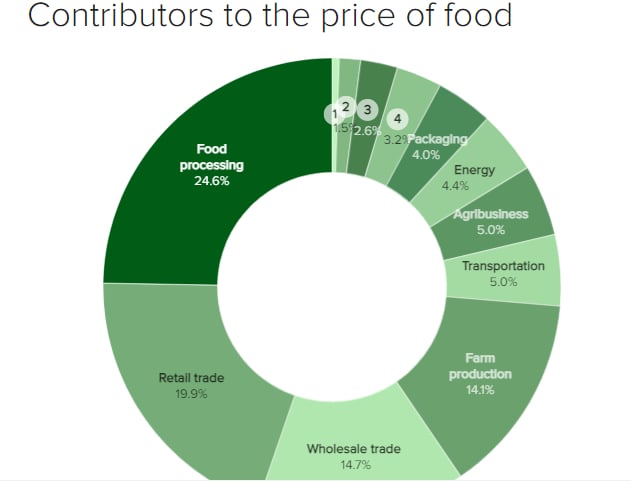November 27, 2025 | 07:24 GMT +7
November 27, 2025 | 07:24 GMT +7
Hotline: 0913.378.918
November 27, 2025 | 07:24 GMT +7
Hotline: 0913.378.918
Supermarket prices have shot up at the fastest rate in decades, putting staples like eggs and bread out of reach for some.

1Food services2Legal and accounting3Advertising4Finance and insurance
Source: GAO; USDA
Over the past two years, egg prices have nearly doubled, leading some consumers to extreme workarounds like trying to smuggle eggs from Mexico and painting "Easter potatoes" instead of dying eggs, to save on household funds. Meat, fish and chicken are all substantially pricier than they were two years ago, as well as cereal and bread, which cost nearly 25% more today than they did in 2021.
So where does the money from those price hikes go? A report from the Government Accountability Office this week breaks down the various pressures on food prices while putting the recent inflation into context.
According to the GAO, there were kinks all along the journey of food, from farm to plate.
Higher costs for animal feed and fertilizer contributed to steeperprices for farmers, while shortages of packaging materials impacted the food-processing stage — such as when peanuts are ground up to make peanut butter.
The GAO also broke down the various segments of food production and their role in the price of items on the shelf. The largest component was food processing, a segment that encompasses food and beverage manufacturers, which took 25 cents out of every food dollar. That was followed by retail trade — the store, supermarket or other retailer that sells consumers that peanut butter.
The cost of actually growing the food — called farm production — accounted for just 14 cents, while agribusiness (which includes the producers of fertilizer and feed that farmers buy) took another 5 cents.
The GAO noted that supply-chain shocks related to COVID-19 affected many parts of the food chain, contributing to price hikes.
"For example, higher animal feed costs predominantly affect the production segment of the supply chain. In contrast, higher energy costs (e.g., fossil fuels and renewables) can affect entities that use energy throughout the food supply chain," the GAO wrote.
A major factor that goes unnoticed in this analysis is the role of profits. Put differently, if one-fourth of the cost of your peanut butter jar goes to the company that ground and packaged the peanuts, how much of that increased sum of money is going to cover the factory's higher costs of energy, equipment and pay, and how much goes toward padding the pockets of factory owners?
The GAO report doesn't separate out profits, but plenty of other evidence suggests they are a substantial component of inflation. In 2022, corporate profit margins surged to their highest level since the 1950s. Research from the Roosevelt Institute's Mike Konczal found that "firms increased their markups substantially in 2021, both to their highest level and with the largest single-year increase since 1955. Firm profitability, both before and after taxes, also increased to its highest levels," Konczal wrote. Plenty of retail executives have boasted to investors of their ability to hike prices in the pandemic's aftermath.
The Federal Trade Commission is currently looking into the possibility of price-gouging. Late in 2021, the FTC launched an investigation into major retailers and consumer-goods companies, including Amazon, Kroger, Walmart, Kraft Heinz and Procter and Gamble.
(CBS News)

(VAN) A new study reveals how the simultaneous effects of ocean acidification, salinity and loss of oxygen are making the world more fragile.

(VAN) Hopes are growing that the creation of the first 3D turkey gut model could be a turning point in the battle against the virulent blackhead disease.

(VAN) Tyson, America’s biggest meat supplier, plans to shutter one of its largest beef processing plants as the industry continues to struggle with low cattle supplies and political pressure from Washington.

(VAN) New FAO study shows how digital solutions are empowering farmers and fishers to prevent losses and build resilient agrifood systems.

(VAN) Brazil's COP30 presidency pushed through a compromise climate deal on Saturday that would boost finance for poor nations coping with global warming but that omitted any mention of the fossil fuels driving it.

(VAN) Poultry farmers in the UK have been warned that they could face one of the worst winters yet for bird flu.

(VAN) Prices of main-crop paddy have risen sharply, with jasmine rice hitting 16,100 baht per tonne — the highest level in years.